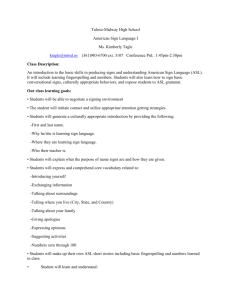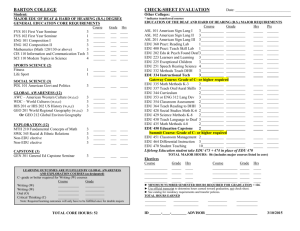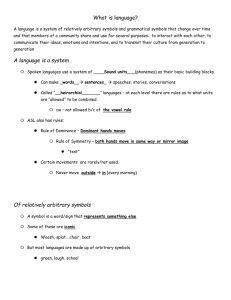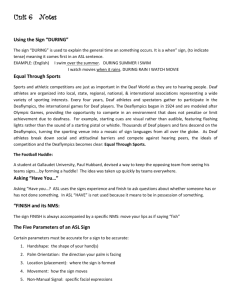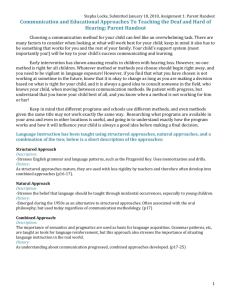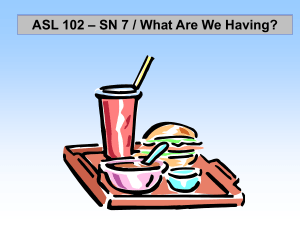Beginning American Sign Language Class Packet ASL Index An
advertisement
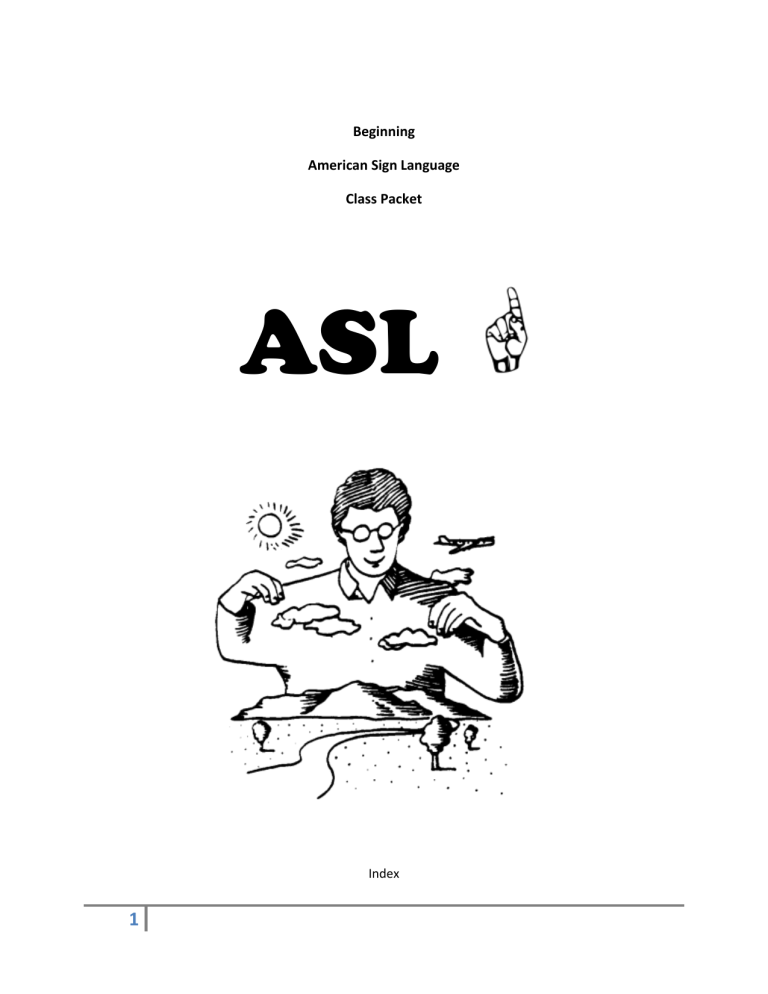
Beginning American Sign Language Class Packet ASL Index 1 An Open Letter………………………………………………………………………………………………………………………………………..3 American Sign Language as a Foreign Language………………………………………………………………………………………4 Glossary…………………………………………………………………………………………………………………………………………………..7 Signing Naturally Curriculum…………………………………………………………………………………………………………………10 American Manual Alphabet and Handshapes………………………………………………………………………………………..11 ASL Numbers 1-10…………………………………………………………………………………………………………………………………14 Fingerspelling in ASL………………………………………………………………………………………………………………………………15 Verb Tense in American Sign Language………………………………………………………………………………………………….16 Let There Be Light………………………………………………………………………………………………………………………………….17 Minimal Pairs………………………………………………………………………………………………………………………………………..18 Spatial Agreement………………………………………………………………………………………………………………………………..19 Noun-Verb Pairs…………………………………………………………………………………………………………………………………..20 Non-Manual Markers (Signals)…………………………………………………………………………………………………………….21 References...…………………………………………………………………………………………………………………………….…….…..22 Helpful Resources ……………………………………………………………………………………………………………………………….23 Note: I’d like to acknowledge Tom Moran who originally created the majority of ASL Packet that this packet was modeled from. Thanks for the head start! 2 Fall 2010 Dear ASL Student: I’m thrilled that you are taking my class! ASL is an enthralling subject and you should expect to learn a great deal about it and about the members of the Deaf communities. I’m very interested in your success, but that is not something that happens automatically or without effort. Please allow me to offer you a bit of advice: 1. This is a language course: you must be ever-present – no ifs, ands, or buts. 2. In order to learn ASL, you must participate. You can’t negotiate your way out of this simple fact. 3. Everyone in my class will treat each other with the utmost respect, including me: a. I won’t play favorites. b. I will assign you the grade that you earned; nothing more, nothing less. 4. I like to keep this class interesting…which means you’ll laugh here and there. Go ahead and laugh! 5. If you’re not sure about anything, please ask – anytime! We’re all students and we’re all teachers. I expect that you will learn from me and I expect to learn from you as well. I’m committed to your education and am prepared to help you in any way I can. I promise to support and encourage you and that I will never belittle nor humiliate you. If you’ve taken ASL with other teachers, you may see me do and sign things differently than they do. That’s good for you and will help your learning. There are other things that will help your learning: work hard, be diligent, do more than the minimum required, help your classmate (without voicing), and always be in class. I look forward to a fantastic semester with you! 3 American Sign Language as a Foreign Language Sherman Wilcox, Ph.D., Associate Professor Department of Linguistics, University of New Mexico Interest in American Sign Language (ASL) as a foreign language has become, in the words of Gary Olsen, former Executive Director of the National Association of the Deaf, “an American ground swell.” Many colleges and universities are beginning to recognize the study of ASL and Deaf culture as legitimate academic pursuits and are starting to accept ASL in fulfillment of their foreign language entrance and exit requirements. In several states, ASL is mandated by law as acceptable in fulfillment of high school foreign language graduation requirements. More and more colleges and universities are accepting ASL in fulfillment of foreign language requirements. The University of California system (all campuses) will soon accept ASL in fulfillment of foreign language entrance and graduation requirements. Harvard and Yale are among some of the schools which are investigating similar action. Recently, we have witnessed tremendous activity by state legislatures to support the teaching and acceptance of ASL as a foreign language. Many states now recognize ASL as a foreign language for the purpose of meeting high school graduation requirements. In 1998, the parliament of the European Community, nothing that there are 500,00 profoundly deaf people in member states whose first language is their national signed language and not the dominant spoken language of their country, recognized as legitimate languages the indigenous signed languages of the twelve member states. Recognition and acceptance of signed languages is clearly an idea whose time has come on an international scale. Many questions come to mind when the topic of ASL as a foreign language is brought up. People often ask if it is appropriate to call ASL as a foreign language. Is it really a language? Isn’t it a derivative of English, on the order of Black English? Is ASL “foreign”? –after all, it is used in the United States. Is there a body of literature associated with ASL? Others may note that foreign language courses teach students about the culture of a group of people who use the language. They may wonder if there is a full and distinct culture associated with users of ASL. The answers to all of these questions support the recognition of ASL as a foreign language. Because of its unique modality—visual/gestural rather than aural/oral—many people wrongly assume that ASL is fundamentally different than spoken languages. ASL is a fully developed human language, one of the hundreds of naturally occurring signed languages of the world. It is not a derivative of English. It is not a “simplified” language—it contains structures and processes which English lacks (such as ASL’s rich verbal aspect and classifier systems). There are abundant linguistic research on ASL demonstrating that the grammar of ASL is radically different from English—surely as different as any of the more traditional foreign sign languages taught in school. Comprehensive sources of information on the linguistics of ASL are Linguistics of American Sign Language by Clayton Valli and Ceil Lucas (1993, Gallaudet University Press), American Sign Language: Linguistic and Applied Dimensions by Ronnie Wilber (1987, Little Brown and Co.) and The Signs of Language by Edward Klima and Ursula Bellugi (1979, Harvard University Press). The question of whether ASL is “foreign” depends on what we mean by foreign. ASL is not universal: it is indigenous to the United States and parts of Canada. This should not, however, exclude it from study as a foreign language. The question also arises with other languages indigenous to North 4 America. At the University of New Mexico, for example, Navajo is taught and accepted in fulfillment of the foreign language requirement, yet it is not used in a foreign country. For reasons such as this, many language scholars now speak of a second language, rather than foreign language, requirements. Some people may suggest that ASL lacks an international scope. In the hearing world of international world affairs this is true. It is also true for many of the spoken language traditionally accepted to fulfill foreign language requirements. On the other hand, in the Deaf world, ASL is quite an important language on the international scene; for example, ASL is often an official language of international conferences. There is a rich body of ASL literature by and about Deaf people, as well as texts on ASL in both written and oral modes. The folk heritage of Deaf people, passed down through generations of ASL users, includes legends, naming practices, tall tales, jokes, word play, games, poetry, customs, rituals, and celebrations. For more examples of the heritage and folklore of Deaf people, Jack Gannon’s Deaf Heritage: A Narrative History of Deaf America (1981, National Association of the Deaf) is an excellent source. Foreign Language study necessarily involves learning about the values, worldview, and the way of life—culture—of a group of people. The same is true for the study of ASL. ASL students learn about the rich cultural life of Deaf people. Deaf culture is now recognized and studied by anthropologists, ethnographers, folklorists, and others interested in culture and cross cultural communication. One excellent description of Deaf culture is the recent book by Carol Padden and Tom Humphries, Deaf in America: Voices from a Culture (1988, Harvard University Press). American Deaf Culture: An Anthropology, by Sherman Wilcox (Linstok Press, 1989), contains several articles presenting a variety of perspectives on the language and culture of Deaf people in America. Oliver Sacks’ recent book, Seeing Voices (University of California Press, 1989) is an introduction to Deaf culture, ASL, and the struggle of Deaf people to gain control of their individual and community identity. The facts are overwhelming. ASL is a true human language full distinct from English with its own literature and culture. It is important to go beyond these facts, however, and to ask whether, by offering ASL as a foreign language option, we do students an injustice by steering them away from courses which could be of more intellectual or economic value. Is ASL instruction a worthwhile addition to the curriculum? The answer clearly is “Yes—absolutely!” One of the educational benefits of foreign language study is that it gives students a fresh perspective on their own language and culture. This is especially true of ASL. Applying linguistic and anthropological methods to the study of ASL and Deaf culture is an excellent intellectual exercise for students. It leaves them with a better understanding of another people’s language and customs, as well as a deeper appreciation of their own language and culture. We do not teach languages only for the intellectual rewards. There are also practical, economical reasons for learning a foreign language. For example, our nation’s businesses need employees who can understand the language and customs of foreign nationality. Again, the facts do not support such a contention. For example, students in the bachelor of science degree program in sign language interpreting at the University of New Mexico are regularly recruited into competitive positions in business, education, and government. Many students report that they take ASL specifically to make them better qualified or more employable in non-deafness related careers. Those students who want to continue their education at the graduate level find that a background in ASL opens up several avenues 5 for advanced study and research. Finally, some might wonder whether offering ASL as a foreign language option will cause a decline in enrollment in other foreign languages. The evidence from these universities which will accept ASL as a foreign language is precisely the opposite. At these universities there is no record of a decrease in traditional foreign language enrollment due to enrollments in ASL. As a matter of fact, ASL instruction may lead to increased foreign language enrollment. ASL students often report that they are more interested in other languages—and indeed more likely to take a traditional, spoken foreign language— as a result of their ASL study. The joy of learning a new language and of communicating with people across cultural boundaries, it seems, is contagious! Students who know a foreign language commonly find that their perceptions of themselves and the world are richer than their monolingual peers. The study of a language, culture, and literature different than their own propels students beyond the limits of their own world. In all respects ASL affords students the same challenges and rewards as more traditional foreign languages. Copyright 1991 Sherman Wilcox http://www.unm.edu/~wilcox/ASLFL/asl_fl.html 6 Glossary 1. ASL: American Sign Language. The daily language of nearly one million Americans. It is commonly believed that ASL is the third most commonly used language in the U.S., but this is not the case: however, it is a popular language. It was based largely on French Sign Language (LSF) and was brought to the U.S. by Laurent Clerc, a Deaf French education of Deaf children, who partnered with Rev. Thomas H. Gallaudet to open the first public school for Deaf people in 1817. 2. audism: A term coined by Tom Humphries in 1975. Audism is a form of discrimination that one is superior based on one’s ability to hear or behaves like a hearing person. Unfortunately, this particular discrimination is not yet recognized in the eyes of the law. However, there are other ways. 3. CODA/Coda: Child Of Deaf Adult(s). A hearing individual who has/had, at least, one Deaf parent. More likely than not, his/her first language was ASL before learning English. Codas are often “outsiders” because they are hearing people yet they have grown up in “the Deaf way”. 4. deaf: This term is used to describe an auditory pathology, that is the inability to hear, or hear well enough to transact a spoken conversation. The term “deaf” with a lowercase “d” is used to describe the condition of deafness or a person who is not a member of the American Deaf Culture. 5. Deaf: Note the capital “D”; this is the term used to describe members of the North American Deaf Culture. Note the capital “D”, which denotes a proper noun, much in the same way you might refer to someone as “Chinese” or an “African-American.” Refer to people who have a hearing loss and are members of a culture as “Deaf people” or “people who are Deaf.” Never refer to them as “the Deaf” or in a manner such as “I saw a Deaf.” 6. deaf and dumb: This is a discontinued term from times gone by. Here the term “dumb” means unable to speak; unfortunately, it s homonym means “unintelligent.” Too often Deaf individuals are perceived of as unintelligent or incapable, and usually this is not the case. This was a very common term and you will see it still, from time to time, in the media. Never use this term. 7. Deaf Culture: See Deaf World. 8. deaf-mute: This was a term popular up until the mid-20th century. It is no longer used and has become discontinued. It incorrectly describes people who are Deaf. The inability to hear makes it very difficult to modulate one’s voice and to pronounce words correctly; however, almost all Deaf people possess the power of speech. Rarely is a Deaf person actually “mute,” though many choose not to speak. 9. Deaf World: This is somewhat an antiquated term, the way in which Deaf people used to refer to their collective experience: no telephones, residential schools, menial jobs, Deaf spouses, etc. Typically we now refer to the collective experience in North American Deaf people (and Deaf people from around the world) as Deaf culture. 7 10. facial expressions: Facial expressions are emotive and universal. In every culture the same facial expression means, “OW! I just hit my thumb with a hammer,” or “I love you.” People who don’t understand sign language often confuse ASL’s non-manual grammar with emotive facial expressions, leading them to conclude that “ASL is SO expressive!” 11. gesture: The use of movement to convey a message; more purposeful than body language, but not a language governed by a grammar. One uses basic invented gestures to play the party game, Charades. Someone who is skilled at gestures—like a certified Deaf interpreter-can communicate quite effectively with individuals who have little expressive or receptive language. 12. hearing: This term is applied to people who have no hearing loss. Most of the students who take my class are hearing. Do not refer to hearing people as “speaking.” All too often people confuse the ability to speak with the ability to think or reason; on the contrary, if you listen to talk radio, you will quickly learn that there is no link between the ability to speak and the ability to think. Almost all Deaf people are capable of speech but choose to sign, as it is easier and more comfortable—in a word, natural. 13. hearing impaired: Much has been said and written on the origin of this term. Some think it is politically correct. Others think it is an economics term coined to talk about 20,000,000 Americans— many of them—elderly—who have significant form of hearing loss. It does not refer to members of a culture, and Deaf people rarely refer to themselves as “hearing impaired.” 14. interpreter: An individual trained in interpreting and transliterating who is fluent in at least two languages, in our case, English and ASL. 15. MCE: Manually-Coded English. Whereas ASL is its own language, many people (most of them hearing) believe that if teachers sign in the English word order, with symbols invented to mimic our syntax and phonology, Deaf students will improve their written English. This method has been tried since at least the early 18th century. An experiment as old as deaf education itself, it is largely a failure. 16. manual communication: Communicating by using the hands and “body language.” Its counterpart is verbal communication. 17. non-manual behavior: A form of communication which is non-verbal as well as non-manual, that is not on the hands. Non-manuals are movements of the face, head, shoulders, and upper body which have grammatical meanings in ASL. For example, if you tilt your head to your shoulder, you are indicating spatial or temporal immediacy (“he’s right there”; “she just left”). If you raise your eyebrows, you are asking a yes/no question. Non-manual behaviors are sometimes referred to as the grammar of ASL. 18. oralism: This is the method of instruction wherein a teacher mouths every word to a Deaf person and asks the Deaf person to speak normally in spite of his inability to hear himself. A product of the Victorian age—and the preferred method of instruction in most countries around the world—it was standard procedure in the U.S. until the 1970s. There are schools that practice this method to this day. 8 Many Deaf people are raised and educated by the oral method. A vast majority of them turn to ASL at some point of their lives. 19. Pidgin Signed English: See “MCE” 20. SEE: See “MCE” 21. Signed English: See “MCE” 9 The Signing Naturally Curriculum As you know by now, the text we are using for this course is Signing Naturally, Level 1. This is the book that I use to teach ASL 1 (or in the college level, ASL 1 & ASL 2). For those students continuing in their studies, instructors generally use Signing Naturally, Level 2 for ASL 2 (or in the college level, ASL 3 & ASL 4) and Level 3 for ASL 3 (or in the college level, ASL 5 & ASL 6). I chose this curriculum carefully for a number of reasons which I would like to share with you. 1. Two of the three authors are Deaf; the hearing author is a CODA. All three are native users of ASL. Each is a pioneer in ASL instruction and they are teachers of ASL teachers. They are ASL interpreters, linguists, poets, and each has an advanced degree in language or linguistics. 2. Signing Naturally is the best and most-widely used—by far—ASL curriculum available. If you came from a high school or a college that offered ASL, you’re likely to have used this book. If you plan to transfer and continue your studies elsewhere, you will likely use this curriculum. Among the colleges that use—and endorse—this curriculum are Gallaudet University, CSU Northridge, San Diego State University, the Community College in Baltimore County (CCBC), Towson University, San Antonio College, North Virginia Community College (NVCC), just to name a few. 3. This series uses the most modern second-language teaching methods. Whereas in the past ASL has been taught listing vocabulary or transcribing English sentences, Signing Naturally uses a functional/notional approach. This means ASL is taught using ASL, emphasizing “communicative purpose” in the language we are studying. It means ASL is taught emphasizing the functions of language use in situations students are likely to encounter outside the classroom. 4. Finally, the Signing Naturally curriculum teaches ASL in a way that is respectful of ASL and members of the Deaf communities. To begin with, it encourages a “no-voice” policy. This can be unsettling to students are who are not accustomed to guessing and feeling “off-balance” in a classroom: however, I assure you that it is the quickest and most effective way to learn ASL. In addition, Signing Naturally eschews the use of English “glosses” in labeling signs. A gloss (usually written in all caps, like CAT) is a label, printed in English, below the picture of a sign. While common sense would reason that this would enhance learning, the opposite is actually true. The overwhelming majority of signs can be translated in several, sometimes dozens, of different English words. To label a sign with a single English word is to do a grave disservice to an ASL student, and leads students to asking such ignorant questions as “What’s the sign for ‘run,’” where, in fact there are literally dozens of signs for that single English word, even more than that are definitions of that word. As you can tell, I think highly of this curriculum. I chose to make it both your life and my life easier, and because I think if you use this book to its fullest intent and if you study hard, you will leave this class a competent, beginning ASL user who is comfortable conversing with a stranger. 10 11 12 13 Did you know that… …ASL has recorded the fastest enrollment growth rate (over 400%) of any “foreign language” offered on U.S. college campuses, according to the Modern Language Association? …origins of ASL can be traced to Martha’s Vineyard in the late 1600’s? …in the U.S. approximately 500,000 people use ASL as their primary language? Source: Los Angeles Times, January 18, 2005 14 Fingerspelling in ASL Although debunked by snope.com, try reading the following paragraph quickly: The pweor of the hmuan mnid Aoccdrnig to rsceearh at Cmabrigde Uinervtisy, it deosn't mttaer in waht oredr the ltteers in a wrod are, the olny iprmoatnt tihng is taht the frist and lsat ltteer be in the rghit pclae. The rset can be a taotl mses and you can sitll raed it wouthit a porbelm. Tihs is bcuseae the huamn mnid deos not raed ervey lteter by istlef, but the wrod as a wlohe. Not that hard, is it? This demonstrates the fallacy of trying to see each letter when reading fingerspelled words. Many Deaf children—children not old enough to read—can understand many fingerspelled words. That’s because they recognize the words as whole units, rather than as a series of letters. Being able to recognize all the words in the above paragraph is an example of the three C’s of fingerspelling—Context, Clozure, and Configuration. Context: Once you determine the paragraph is a report in scientific research that reduces the number of possible words you might encounter. Clozure: Because you see the first and last letter of each word in its proper place, it’s much easier to determine what the word is. Similarly, though you may miss some of the internal letters in a fingerspelled word, you can usually see the first and last letter. Configuration: The capitalized letters denote proper nouns (Cambridge University) as well as the beginning of sentences. Additionally, some words have a unique “shape”: research, important, without, and whole. Even scrambled, these words stand out in the paragraph. 15 Verb Tense in American Sign Language Future Distant Future 16 Present Immediate Future Past Recent Past Distant Past Let There Be Light One reason that it is troublesome to label signs with glosses is that one English word can have dozen or more sign possibilities and vice versa. As a simple example of just how complex this issue can be, how would you sign the following sentences? 1. Will you light the fire for me please? 2. Turn out the lights please. 3. She was wearing a coat that was too light and almost froze. 4. She made light of the situation. 5. She had on a light blue dress. 6. There isn’t enough light in here. 7. I ate a light lunch. 8. I slept very light last night. 9. The medicine made me very light-headed. 10. I painted light yellow on the wall last night. In addition, when you ask me to provide a sign, please provide the context. As you can see from the sentences above, there are different possible ways. 17 Minimal Pairs There are five parameters for a sign. They are: 1. Location 2. Handshape 3. Movement 4. Palm Orientation 5. Non-Manual Signal/Marker (NMS) (not always presented) A minimal pair is two signs that differ by only one parameter. Examples: Location: Handshape: Non-manual: 18 SEE – VOICE Movement: VOTE – TEA UGLY – DRY – SUMMER FAKE – MOUSE MISS – THINK FULL – ENOUGH WHITE – LIKE Palm Orientation: THING – CHILDREN KNOW – THINK ESTABLISH – APPOINTMENT CAR – WHICH SCHOOL – PROOF UNDERSTAND – DON’T-UNDERSTAND Spatial Agreement 1. To show that a location or a person is far away: a. Head: b. Eyes: c. Mouth: d. Index finger: tilted squinted open slightly, “ah” trace route, extend arm fully 2. To show that location or a person is at a moderate distance: a. Head: b. Eyes: c. Mouth: d. Index finger: tilted normal purse lips slightly, “mm” trace route, extend arm moderately, about half way 3. To show that a location or a person is very near: a. Head tilted to the dominate side with cheek almost touching raised shoulder b. Eyes: wide open c. Mouth: teeth clenched, “cs” d. Index finger: trace route, keep hand close to body and no arm extension 19 Noun – Verb Pairs One of the most important distinctions of ASL grammar is its verb-modulation system. Whereas in English we modify a verb by changing its spelling, in ASL we modulate a verb with movement. Like English, many verbs are based on nouns. In ASL, a noun has repeated movements to indicate they are nouns. Many verbs move to show the directions of the action. Nouns Verb 1. AIRPLANE FLY 2. BED GO-TO-BED 3. CAMERA TAKE-PICTURE 4. CAR DRIVE 5. CHAIR SIT 6. DOOR 7. FOOD EAT 8. AIR PUMP PUMP AIR 9. BOOK OPEN/CLOSE-BOOK 10. COAT PUT-ON-COAT 11. BACKPACK PUT-ON-BACKPACK 20 OPEN/CLOSE-DOOR Non-Manual Signals/Markers (NMS) These “facial expressions” are not emotive; they are grammatical. One’s eyebrows signal whether one is asking a yes/no question, an information question, or a rhetorical question. Generally, one does not “mouth” words as one signs (though there are exceptions), but one does convey adjectives and adverbs with mouth movements, also known as “mouth morphemes.” Other NMSs include eye movements, head tilts, and body tilts. Non-manual signals are the grammar of ASL. Yes/No Questions Raised Eyebrows Wh- Questions (a.k.a. information Qs) Lowered eyebrows WHO WHAT WHEN WHERE WHY HOW Rhetorical Questions (-with answers) Raised eyebrows WHO WHAT WHEN WHERE WHY HOW A Few Mouth Morphemes: cha: height, length, size luch: jumbo, large pah: finally pow: explode, hit hard, hot temper puh: tend, give in bro: burned-out bulb, break, broke ahh: fear th: not yet pth: melt, smash cs: near (physically or temporally) mm: normal, relax, take tame ps-ps: fancy, chic shh: wild time, make out 21 References http://gupress.gallaudet.edu/pics/ASLHSpic1.jpg http://media.photobucket.com/image/light%20bulb/bethdj/Light_Bulb_LOW.jpg http://www.arinc.com/locations/directions/ams_map1.gif http://www.citytowninfo.com/images/state-maps/maryland-reference.gif http://www.dchrp.info/images/DCmap.gif http://www.lifeprint.com/asl101/images-signs/apple.gif http://www.mexfogel.com/3D_Girl/FaceProfile.jpg http://www.shsu.edu/~soc_www/images/around_world.jpg http://www2.bakersfieldcollege.edu/tmoran/ASL%201%20Class%20Pack%2008.pdf https://www.crowdirect.co.uk/case/images/traffic_light_-_caution.gif 22 Helpful Resources Online ASL Dictionary: http://www.ASLPro.com http://www.lifeprint.com Other ASL and Deaf resources: http://www.nad.org http://www.gallaudet.edu http://www.aslhonorsociety.org http://www.deaf.com http://www.vsdb.state.va.us http://www.msd.edu http://www.rid.org http://www.deafnation.com Good online resources for Deaf events: http://www.nvrc.org 23

